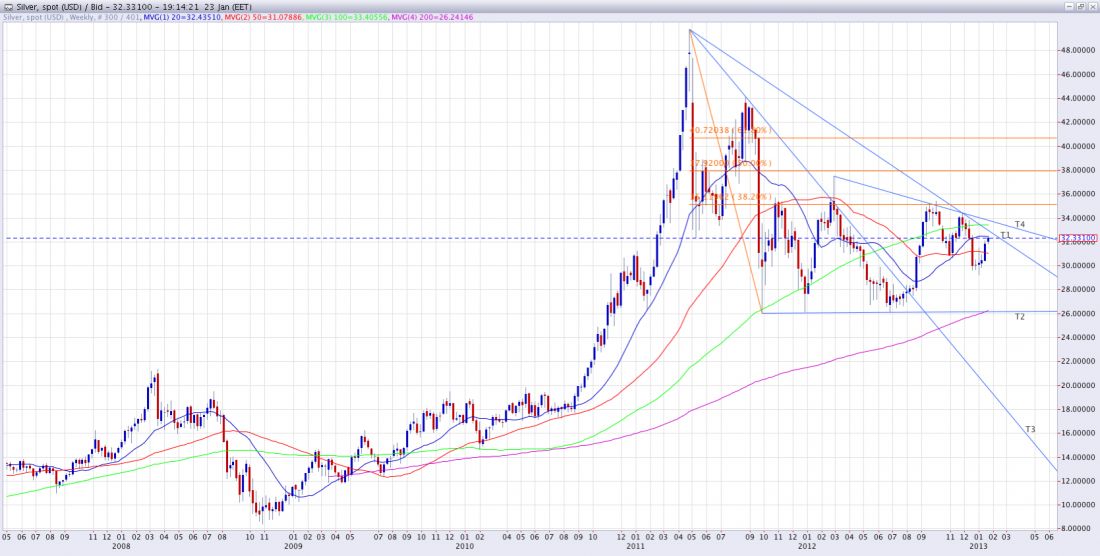This week, the precious metals are being underpinned by fresh monetary easing by the Bank of Japan, amid heightened worries about central bank independence. The BoJ doubled its inflation target to 2% on Tuesday and pledged to buy an additional ?13 trillion in assets each month beginning in 2014. This move was widely expected in light of the intense political pressure applied by the new Prime Minister, prompting Bundesbank President Jens Weidmann to call out Japan specifically for “alarming violations” of central bank autonomy. I presume Weidmann was referring in part to Abe’s threat to nationalize the BoJ if they didn’t see things his way.
BoJ governor Shirakawa categorized the new policy as “a resolute advance” toward easier money. In fact, the BoJ policy rate has been 0.0-0.1% for four-years now; money can’t get much easier than that. It’s amusing that the 2007 high in the call rate at 0.5% would now be considered extremely tight policy. Rates haven’t been above 1% in Japan since the mid-1990s.
So as Japan advances resolutely toward easier money, it’s worth noting that this strategy has been a pretty decisive failure since the BoJ began cutting rates more than twenty-years ago. Ah, but easier monetary policy is the path of least resistance, requiring little effort (save a little arm twisting) on the part of politicians. In fact, it frequently allows those politicians to avoid — or perhaps more accurately forestall — painful fiscal reforms. I suspect that when PM Abe gets to install his own man to head the BoJ in April, we’ll see those new asset purchases sooner rather than later.
Mohamed El-Erian, CEO and co-CIO of bond giant PIMCO, wrote yesterday that “Japan is not the first country to go down [the path of actively trying to weaken its currency]. Several advanced and emerging economies preceded it, and I suspect that quite a few will follow it.”
The prospect of a currency war seems be an overarching theme at this year’s World Economic Forum in Davos as well. If the world’s financial, political and academic powerhouses are concerned about beggar-thy-neighbor currency devaluations, perhaps you should be as well.
Gold of course is the classic hedge against currency debasement, but hard assets in general should benefit as investors seek shelter from currency devaluation. As we noted in last week’s commentary, the white metals (led by platinum) have been outperforming so far this year. Silver is up an impressive 7.1% so far in 2013. By comparison, gold is up a scant 1% since the first of the year. So, let’s take a quick look at silver:
Silver has pushed convincingly back above $32.00 this week, establishing new five-week highs and threatening the 100-day moving average at $32.57. As the near-term technical picture brightens, it’s important to remember that silver has been confined to a broad — nearly $24 dollar — range since 2011. To provide a little perspective, the midpoint of that range is presently well protected at $37.93.
While recent tests below the 200-day moving average warrant a measure of caution, these losses could not be sustained and silver is now comfortably 5.5% above this important longer-term indicator of trend. While the volatility in recent years has been considerable, action since the high just below $50 was established in April 2011 has the characteristics of a continuation pattern. When you consider that silver was trading in the <$4-$8 range from the mid 1980s until 2005, I'm going to say the underlying trend is still positive.
Inflows into derivatives indexed to the price of silver have been very strong in recent weeks, but more significantly demand for physical silver has been nothing short of robust. The U.S. mint sold out of the new 2013 strikes of the popular silver eagle within the first two weeks of the year, resulting in a suspension of sales that continues to this day as the mint works to replenish its inventory. The supply dearth has driven premiums significantly higher on one ounce bullion coins.
Chinese demand for silver is living up to expectations for a 10% increase this year. Many Chinese are viewing silver as a less expensive alternative to gold as a means of wealth preservation.
GoldCore reported today that HSBC has been quietly “acquiring large amounts of silver bullion.” HSBC reportedly has purchases $876 million (PLN3.65 bln) worth of silver from Polish producer and refiner KGHM in the past twelve-months alone, with a contract in place to provide PLN1.67 bln worth of silver in 2013.
This revived demand has pushed the gold/silver ratio nearly back to 52. The ratio peaked just above 56 on January 4. If gold remains narrowly confined just below $1700, and the ratio continues its retreat to 50, that would project silver in the short-term to $34.

= = =
Read a Feature story:




